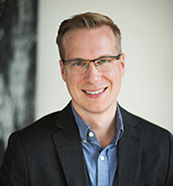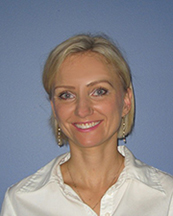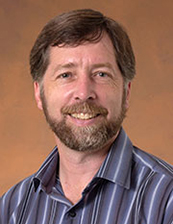Autonomous Vehicles and Machines 2017
Monday January 30, 2017
KEYNOTE: Architectures for Automated Driving
Session Chair: Buyue Zhang, Intel Corporation (United States)
8:50 – 9:50 AM
Grand Peninsula Ballroom B
AVM-009
Architectures for automated driving, Jack Weast, Intel Corporation (United States)
 Jack Weast is a Principal Engineer and the Chief Systems Engineer for Autonomous Driving Solutions at Intel Corporation. In his 17 year career at Intel, Weast has built a reputation as a change agent in new industries with significant technical and architectural contributions to a wide range of industry-first products and standards that range from one the world’s first Digital Media Adapters to complex heterogeneous high performance compute solutions in markets that are embracing high performance computing for the first time. With an End to End Systems perspective, he combines a unique blend of embedded product experience with a knack for elegant Software and Systems design that will accelerate the adoption of Autonomous Driving. Weast is the co-author of “UPnP: Design By Example”, an Associate Professor at Portland State University, and the holder of numerous patents with dozens pending. Jack Weast is a Principal Engineer and the Chief Systems Engineer for Autonomous Driving Solutions at Intel Corporation. In his 17 year career at Intel, Weast has built a reputation as a change agent in new industries with significant technical and architectural contributions to a wide range of industry-first products and standards that range from one the world’s first Digital Media Adapters to complex heterogeneous high performance compute solutions in markets that are embracing high performance computing for the first time. With an End to End Systems perspective, he combines a unique blend of embedded product experience with a knack for elegant Software and Systems design that will accelerate the adoption of Autonomous Driving. Weast is the co-author of “UPnP: Design By Example”, an Associate Professor at Portland State University, and the holder of numerous patents with dozens pending. |
Multi-Camera and Embedded Systems for Autonomous Machines
Session Chair:
Buyue Zhang, Intel Corporation (United States)
9:50 – 10:30 AM
Grand Peninsula Ballroom B
9:50AVM-010
3D Perception: Multi-camera embedded structure-from-motion prototype for real-time mapping, Martin Mueller1, Vikram Appia1, and Umit Batur2; 1Texas Instruments Inc. and 2Faraday Future (United States)
10:10AVM-451
Measuring MTF with wedges: Pitfalls and best practices, Norman Koren, Robert C. Sumner, and Henry Koren, Imatest LLC (United States)
10:30 – 10:50 AM Coffee Break
Multi-Camera and Embedded Systems for Autonomous Machines (cont.)
Session Chairs:
Darnell Moore, Texas Instruments, and Yi Zhang, Ford Research and Innovation Center (United States)
10:50 AM – 12:30 PM
Grand Peninsula Ballroom B
10:50AVM-012
Free-view multi-camera visualization and harmonization for automotive systems, Vladimir Zlokolica, Brian Deegan, Patrick Denny, Mark Griffin, and Barry Dever, Valeo Vision Systems (Ireland)
11:10AVM-013
Accelerated stereo matching for autonomous vehicles using upright pinhole camera model, Chen Chen1, Jiangbo Lu2, Do-Kyoung Kwon3, Darnell Moore3, and Minh N. Do1; 1University of Illinois at Urbana-Champaign (United States), 2Advanced Digital Sciences Center (Singapore), and 3Texas Instruments (United States)
11:30AVM-014
Perspectively correct bird’s views using stereo vision, Christian Fuchs and Dietrich Paulus, University of Koblenz-Landau (Germany)
11:50AVM-015
A sense and avoid algorithm using surround stereo vision for drones, G.M. Dilshan Godaliyadda1,2, Do-Kyoung Kwon2, Darnell Moore2, and Victor Cheng2; 1Purdue University and 2Texas Instruments (United States)
12:10AVM-011
Real-time flight altitude estimation using phase correlation with gram polynomial decimation, Amir Badshah1, Aadil Choudhry2, and Saadullah Amin2; 1International Islamic University Islamabad and 2National University of Sciences and Technology (Pakistan)
12:30 – 2:00 PM Lunch Break
EI 2017 Opening Plenary and Symposium Awards
Session Chairs: Joyce E. Farrell, Stanford University, and Nitin Sampat, Rochester Institute of Technology (United States)
2:00 – 3:00 PM
Grand Peninsula Ballroom D
Giga-scale 3D computational microscopy, Laura Waller, University of California, Berkeley (United States)
Laura Waller is the Ted Van Duzer Endowed Assistant Professor of Electrical Engineering and Computer Sciences (EECS) at UC Berkeley. She is a Senior Fellow at the Berkeley Institute of Data Science, and received her BS (2004), MEng (2005), and PhD (2010) in EECS from the Massachusetts Institute of Technology (MIT). Waller's talk is on computational imaging methods for fast capture of gigapixel-scale 3D intensity and phase images in a commercial microscope that employs illumination-side and detection-side coding of angle (Fourier) space with simple hardware and fast acquisition. The result is high-resolution reconstructions across a large field-of-view, achieving high space-bandwith-time product.
3:00 – 3:30 PM Coffee Break
KEYNOTE: Functional Safety in Autonomous Systems, Needs and Challenges Analysis
Session Chair: Umit Batur, Faraday Future (United States)
3:30 – 4:30 PM
Grand Peninsula Ballroom B
AVM-016
Functional safety in autonomous systems, needs and challenges analysis, Justyna Zander, NVidia Corporation (United States)
 Justyna Zander recently started working at NVidia to support autonomous driving efforts. Before she was a Software Architect and Technology Lead in autonomous driving at Intel Corporation. Before joining Intel, she spent over a year working on self-driving cars, ADAS, and functional safety as a senior consultant in Germany. She engaged with Fortune 500 companies including most prestigious automotive OEMs. Prior to that, Zander was a postdoctoral research scientist at Harvard University and a senior scientist at the Fraunhofer Institute in Germany. She holds PhD, MSc, and two BSc degrees in Computer Science and Electrical Engineering. Her expertise includes modeling, simulation, deep learning, validation, and verification, functional safety, computing platforms, and rapid prototyping with worldwide operations focus. A frequent public speaker, she holds 6 patents, has 10 patent applications at USPTO, and has co-authored more than 40 publications and 3 books. Her publications have been cited more than 560 times. Zander is recognized internationally with countless awards (IEEE, European Union, NIST, etc). She regularly serves as a technical committee member for more than 50 journals and conferences, and is invited by NSF, EU Commission, and national councils to advise on government strategy and research roadmaps. Justyna Zander recently started working at NVidia to support autonomous driving efforts. Before she was a Software Architect and Technology Lead in autonomous driving at Intel Corporation. Before joining Intel, she spent over a year working on self-driving cars, ADAS, and functional safety as a senior consultant in Germany. She engaged with Fortune 500 companies including most prestigious automotive OEMs. Prior to that, Zander was a postdoctoral research scientist at Harvard University and a senior scientist at the Fraunhofer Institute in Germany. She holds PhD, MSc, and two BSc degrees in Computer Science and Electrical Engineering. Her expertise includes modeling, simulation, deep learning, validation, and verification, functional safety, computing platforms, and rapid prototyping with worldwide operations focus. A frequent public speaker, she holds 6 patents, has 10 patent applications at USPTO, and has co-authored more than 40 publications and 3 books. Her publications have been cited more than 560 times. Zander is recognized internationally with countless awards (IEEE, European Union, NIST, etc). She regularly serves as a technical committee member for more than 50 journals and conferences, and is invited by NSF, EU Commission, and national councils to advise on government strategy and research roadmaps. |
Functional Safety
Session Chair:
Umit Batur, Faraday Future (United States)
4:30 – 4:50 PM
Grand Peninsula Ballroom B
4:30AVM-017
Enabling functional safety ASIL compliance for autonomous driving software systems, Kedar Chitnis1, Mihir Mody1, Pramod Swami1, Sivaraj R1, Chaitanya Ghone1, Biju Mg1, Badri Narayanan1, Yashwant Dutt1, and Aish Dubey2; 1Texas Instruments India Ltd. (India) and 2Texas Instruments (United States)
5:00 – 6:00 PM All-Conference Welcome Reception, Atrium
Tuesday January 31, 2017
KEYNOTE: Autonomous Navigation on Earth and in Space
Session Chair: Darnell Moore, Texas Instruments (United States)
8:50 – 9:50 AM
Grand Peninsula Ballroom B
AVM-018
Common themes in autonomous navigation on earth and in space, Larry Matthies, Jet Propulsion Laboratory (United States)
 Larry Matthies received his PhD in computer science from Carnegie Mellon University in 1989, then moved to the Jet Propulsion Laboratory, where he a Senior Research Scientist and supervisor the Computer Vision Group. His research interests include 3-D perception, state estimation, terrain classification, and dynamic scene analysis for autonomous navigation of unmanned vehicles on Earth and in space. He has been a principal investigator in many programs involving robot vision funded by NASA, Army, Navy, DARPA, and commercial sponsors. He and his group have achieved several firsts in computer vision for space exploration, including development of vision algorithms used by rovers and landers in the 2003 Mars Exploration Rover mission. He is an Adjunct Professor of Computer Science at the University of Southern California, a lecturer in computer vision at Caltech, and a member of the editorial boards of the Autonomous Robots journal and the Journal of Field Robotics. He is a Fellow of the IEEE and was a joint winner in 2008 of the IEEE's Robotics and Automation Award for his contributions to robotic space exploration. Larry Matthies received his PhD in computer science from Carnegie Mellon University in 1989, then moved to the Jet Propulsion Laboratory, where he a Senior Research Scientist and supervisor the Computer Vision Group. His research interests include 3-D perception, state estimation, terrain classification, and dynamic scene analysis for autonomous navigation of unmanned vehicles on Earth and in space. He has been a principal investigator in many programs involving robot vision funded by NASA, Army, Navy, DARPA, and commercial sponsors. He and his group have achieved several firsts in computer vision for space exploration, including development of vision algorithms used by rovers and landers in the 2003 Mars Exploration Rover mission. He is an Adjunct Professor of Computer Science at the University of Southern California, a lecturer in computer vision at Caltech, and a member of the editorial boards of the Autonomous Robots journal and the Journal of Field Robotics. He is a Fellow of the IEEE and was a joint winner in 2008 of the IEEE's Robotics and Automation Award for his contributions to robotic space exploration. |
Computer Vision, Machine Learning, and Image Processing
Session Chair:
Darnell Moore, Texas Instruments (United States)
9:50 – 10:10 AM
Grand Peninsula Ballroom B
9:50AVM-019
Milpet – The self-driving wheelchair, Samuel Echefu, Jacob Lauzon, Suvam Bag, Rasika Kangutkar, Amar Bhatt, and Raymond Ptucha, Rochester Institute of Technology (United States)
10:00 AM – 7:30 PM Industry Exhibition
10:10 – 10:40 AM Coffee Break
Computer Vision, Machine Learning, and Image Processing (cont.)
Session Chairs:
Markus Vill, Intel Corporation (Germany), and Buyue Zhang, Intel Corporation (United States)
10:40 AM – 12:40 PM
Grand Peninsula Ballroom B
10:40AVM-020
Efficient pre-processor for CNN, Mihir Mody, Manu Mathew, and Shyam Jagannathan, Texas Instruments India Ltd. (India)
11:00AVM-021
Free-space detection with self-supervised and online trained fully convolutional networks, Willem P. Sanberg, Gijs Dubbelman, and Peter H.N. De With, Eindhoven University of Technology (the Netherlands)
11:20AVM-022
Motion estimation using visual odometry and deep learning localization, Suvam Bag, Vishwas Venkatachalapathy, and Raymond Ptucha, Rochester Institute of Technology (United States)
11:40AVM-023
Deep reinforcement learning framework for autonomous driving, Ahmad El Sallab, Mohammed Abdou, Etienne Perot, and Senthil Yogamani, Valeo (Ireland)
12:00AVM-024
Automatic glare detection via photometric, geometric, and global positioning information, Mehran Andalibi1 and Damon M. Chandler2; 1Embry-Riddle Aeronautical University (United States) and 2Shizuoka University (Japan)
12:20AVM-025
Face pose estimation from rigid face landmarks for driver monitoring systems, Bhawani Shankar, Jayachandra Dakala, and Kalyan Kumar Hati, Path Partner Technology Pvt Ltd. (India)
12:40 – 2:00 PM Lunch Break
EI 2017 Tuesday Plenary and Symposium Awards
Session Chairs: Joyce E. Farrell, Stanford University, and Nitin Sampat, Rochester Institute of Technology (United States)
2:00 – 3:00 PM
Grand Peninsula Ballroom D
VR 2.0: Making virtual reality better than reality, Gordon Wetzstein, Stanford University (United States)
Gordon Wetzstein is an Assistant Professor of Electrical Engineering and, by courtesy, of Computer Science, at Stanford University, and leads the Stanford Computational Imaging Group. He received a PhD in computer science from the University of British Columbia (2011) where his doctoral dissertation focused on computational light modulation for image acquisition and display. In his talk, Wetzstein explores the frontiers of VR systems engineering. Eventually, VR/AR systems will redefine communication, entertainment, education, collaborative work, simulation, training, telesurgery, and basic vision research, as next-generation computational near-eye displays evolve to deliver visual experiences that are better than the real world.
3:00 – 3:30 PM Coffee Break
5:30 – 7:30 PM Symposium Demonstration Session, Grand Peninsula Ballroom E
Thursday February 2, 2017
KEYNOTE: Automotive Imaging
Session Chairs: Arnaud Darmont, APHESA SPRL (Belgium); Ralf Widenhorn, Portland State University (United States); and Buyue Zhang, Intel Corporation (United States)
11:50 AM – 12:30 PM
Harbour A,B
This session is jointly sponsored by: Image Sensors and Imaging Systems 2017 and Autonomous Vehicles and Machines 2017.
IMSE-196
Automotive imaging, Patrick Denny, Valeo (Ireland)
|
Patrick Denny is a Senior Research Engineer and a Valeo Senior Expert and has worked for the last 15 years at Valeo Vision Systems, Ireland. He received his PhD in physics (2000) from the National University of Ireland, Galway, where he is also Adjunct Professor of Automotive Electronics. Denny has in excess of 20 years experience in scientific and technological development internationally, designing, innovating and developing automotive imaging technologies for BMW, Jaguar Land Rover, Daimler, VW and other OEMs. His research interests include several aspects of automotive vision system image quality, sensor components, algorithmic design, systems, machine learning and data analytics. |
12:30 – 2:00 PM Lunch Break